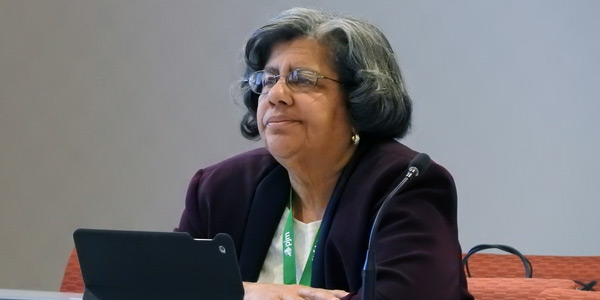By Rory D. Sweeney
VALLEY FORGE, Pa. — The Northern Virginia Electric Cooperative (NOVEC) last week added to the pile of proposals to reform PJM’s capacity construct, but the details were familiar for anyone who’s been following the Capacity Construct/Public Policy Senior Task Force (CCPPSTF).
Customized Energy Solutions’ Carl Johnson, representing NOVEC as a member of the PJM Public Power Coalition, acknowledged that the Manassas-based cooperative usually doesn’t take an active role in PJM’s stakeholder process. But Johnson said it felt the need to get involved based on concerns that the existing proposals relied too much on logic and theory and failed to account for sometimes-illogical human behavior.
“Newton, if he’d lived long enough, might have come up with a fourth law: power plants that are in service tend to stay in service,” Johnson said.
NOVEC argued that some of the proposals encourage generators to seek a subsidy designation rather than remove the influence of out-of-market payments from competitive bidding. It’s equally concerned with proposals that would suppress auction prices in a “race to the bottom” and ones that would result in high prices, Johnson said.
“We’re concerned about other proposals making the market considerably more vulnerable,” he said.
NOVEC’s offering proposes revisions that evolved from recommendations previously advanced by James Wilson of Wilson Energy Economics, which consults for consumer advocates in New Jersey, Pennsylvania, Maryland, Delaware and D.C. Wilson argued at the Sept. 11 meeting of the CCPPSTF that “if a state follows a deliberate process and provides the market substantial advance notice of its actions, it should be assumed the market has fully absorbed the resulting resources and there is minimal, if any, impact on the auction prices.”
“We propose a solution … that simply requires that the appropriate information about those resources be published along with the planning parameters for each auction, such that other market participants can set their bids in accord with their expectations of the bidding of those resources,” NOVEC’s proposal explained. “The subsidies would then be added to the resources’ competitive offers, and the resource stack would clear as usual.”
The remaining nine proposals have all added responses to a list of stakeholder questions, including how they would handle subsidized resources and impact other PJM processes.
American Municipal Power’s Steve Lieberman provided additional details on AMP’s proposal that encourage bilateral contracts. It would require that load and capacity resources with bilateral contracts or self-supply notify PJM and the Independent Market Monitor of the arrangement. The contract price would be reported — with the participants’ names masked — by PJM and the IMM after the annual capacity auction.
The proposal is a response to the “mismatch of expectations between the buyers and the sellers,” said AMP’s Ed Tatum. “A better [way] to think about one of our objectives here [is] to make bilaterals more balanced.”
EnerNOC’s Katie Guerry expressed concern that requiring companies like hers to negotiate contracts with every load-serving entity would increase administrative costs greatly and potentially increase prices for customers. Tatum disagreed with Guerry’s assessment but did not elaborate.
LS Power’s Tom Hoatson clarified his company’s perspective on the definition of a subsidy.
“Our view is if [a subsidy is] available to everyone, we probably would not treat it as a subsidy. But we’re open to discussion,” Hoatson said.
Exelon’s Jason Barker asked where the Illinois zero-emission credit program (ZECs) fit because it appears to conform with LS’s definition of being available to all units in the technology class. Hoatson pledged that the company will review the language, saying its intent is to include ZECs.
“Is the purpose just to capture ZECs?” Barker asked, noting that the proposal doesn’t backdate to subsidies prior to 2017.
“No,” Hoatson said, “but they seem to be the new subsidy du jour, so we wanted to capture them.”
Adrien Ford of Old Dominion Electric Cooperative said its proposal was meant to make PJM’s two-stage repricing model “less worse.” PJM’s proposal would remove subsidized units to maintain a competitive clearing price at the expense of so-called “in-between” offers that would clear in the repriced second stage but didn’t in the first stage. ODEC’s proposal was designed to fully synthesize an auction as if subsidized units never existed and competitive units covered the entire demand.
“We think that is a problem with all two-stage approaches, including ours,” she said.
Exelon’s Sharon Midgley said her company would rather not change a thing, even though it offered a proposal.
“Our firm really believes that reforms are not necessary at this time,” she said. “Really, there is no reliability problem here, so we do strongly prefer the status quo.”
NRG Energy’s Neal Fitch called PJM’s proposal “a good working model to start with, with some necessary adjustments.” NRG’s proposal would lower capacity commitments for bids that cleared in the first stage to address “in-between” units with commitments for all resources proportionally reduced below their offer amounts.
Wilson suggested adding a mechanism that would allow units to drop their commitments, arguing that a few units likely would, allowing the remaining units to be committed closer to their full offer. Fitch said the idea was “probably a next-level step” if the proposal is implemented.
Ruth Ann Price, of the Delaware Division of the Public Advocate, asked proposers to analyze how their proposals would impact state renewable portfolio standards, renewable energy credits, ZECs and the Regional Greenhouse Gas Initiative.
PJM plans to conduct a stakeholder poll on the 10 proposals before the task force’s next meeting on Sept. 26. After that, another round of proposal explanations and revisions is likely to follow. The task force hopes to recommend one of them for stakeholder endorsement by the end of the year.







